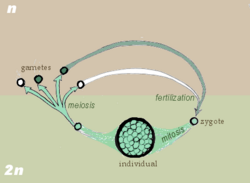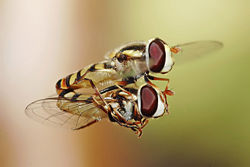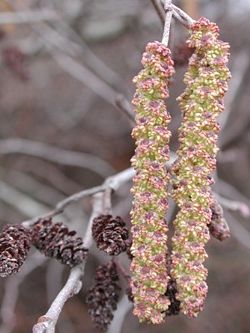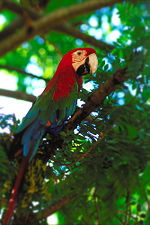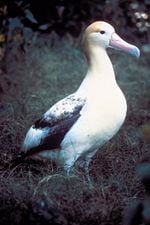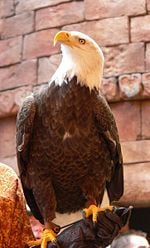Sexual reproduction
Sexual reproduction is a process of biological reproduction by which organisms create descendants that have a combination of genetic material contributed by two different gametes, usually from two different organisms. A gamete is a mature reproductive or sex cell. Sexual reproduction results in increasing genetic diversity, since the union of these gametes produces an organism that is not genetically identical to the parent(s).
Sexual reproduction is characterized by two processes: meiosis, involving the halving of the number of chromosomes to produce gametes; and fertilization, involving the fusion of two gametes and the restoration of the original number of chromosomes. During meiosis, the chromosomes of each pair usually cross over to achieve genetic recombination. Once fertilization takes place, the organism can grow by mitosis.
While typically sexual reproduction is thought of in terms of two different organisms contributing gametes, it also includes self-fertilization, whereby one organism may have "male" and "female" parts, and produce different gametes that fuse.
Sexual reproduction is the primary method of reproduction for the vast majority of visible organisms, including almost all animals and plants. The origin of sex and the prominence of sexual reproduction are major puzzles in modern biology.
Unlike many animals in which sexual activity is restricted to near the time of ovulation, the human menstrual cycle allows reproduction year round and lacks overt signs of the time of ovulation.
Overview: Gametes, meiosis, fertilization, and mitosis
Sexual reproduction involves the fusion or fertilization of gametes from two different sources or organisms.
Typically, a gamete or reproductive cell is haploid, while the somatic or body cell of the organism is diploid. A diploid cell has a paired set of chromosomes. Haploid means that the cell has a single set of unpaired chromosomes, or one half the number of chromosomes of a somatic cell. In diploid organisms, sexual reproduction involves alternating haploid (n) and diploid (2n) phases, with fusion of haploid cells to produce a diploid organism. (See life cycle.) Some organisms, however, exhibit polyploidy, whereby there are more than two homologous sets of chromosomes.
Meiosis and mitosis are an integral part of cell division. Mitosis occurs in somatic (body) cells. The resultant number of cells in mitosis is twice the number of original cells. The number of chromosomes in the daughter cells is the same as that of the parent cell. Meiosis occurs in reproductive or sex cells and results in gametes. It results in cells with half the number of chromosomes present in the daughter cells as are in the parent cell. Essentially, a diploid cell duplicates itself, then undergoes two divisions (tetroid to diploid to haploid), in the process forming four haploid cells. This process occurs in two phases, meiosis I and meiosis II.
Fertilization involves the fusion of haploid gametes to give a diploid organism, which can then grow by mitosis. Thus, in sexual reproduction, each of two parent organisms contributes half of the offspring's genetic makeup by creating haploid gametes that fuse to form a diploid organism.
For most organisms, a gamete that is produced may have one of two different forms. In these anisogamous species, the two sexes are referred to as male, producing sperm or microspores as gametes, and female, producing ova or megaspores as gametes. In isogamous species, the gametes are similar or identical in form, but may have separable properties and may be given other names. For example, in the green alga, Chlamydomonas reinhardtii, there are so-called "plus" and "minus" gametes. A few types of organisms, such as ciliates, have more than two kinds of gametes.
Sexually reproducing organisms have two sets of genes (called alleles) for every trait. Offspring inherit one allele for each trait from each parent, thereby ensuring that offspring have a combination of the parents' genes. Having two copies of every gene, only one of which is expressed, allows deleterious alleles to be masked.
Sexual version asexual reproduction
Sexual reproduction is a near-universal mode of reproduction among eukaryotes. Even some groups of organisms that practice asexual reproduction—such as fungi, certain protists and vascular plants, various invertebrates, and even some reptiles and amphibians—exhibit sexual reproduction as well. Lahr et al. (2011) contend that even in amoeboid lineages the extent of asexual reproduction in overestimated and that the evidence "demonstrates that the majority of amoeboid lineages are, contrary to popular belief, anciently sexual, and that most asexual groups have probably arisen recently and independently." Among animals, nearly all species practice sexual reproduction. Mayr (2001) notes that "above the level of the genus there are only three higher taxa of animals that consist exclusively of uniparentally reproducing clones." (An example of these higher taxa would be rotifers of the Class Bdelloidea.)
The origin and prevalence of sexual reproduction remains a major puzzle in modern biology. Sexual reproduction has many drawbacks, since it requires far more energy than asexual reproduction. For example, in an asexual species, each member of the population is capable of bearing young. Intrinsically, this implies that with each generation, an asexual population can grow more rapidly. An additional cost of sexual reproduction is that males and females must search for each other in order to mate. Mayr (2001) notes that since the 1880s evolutionists have argued over the advantage of sexual reproduction and "so far, no clear-cut winner has emerged from this controversy."
General explanations for the origin and maintenance of sexual reproduction focus on the advantages conferred due to an improvement in the quality of progeny (fitness), despite reducing the overall number of offspring (two-fold cost of sex). This enhanced fitness is explained in terms of the genetic variation that is increased through sexual reproduction. Organisms that reproduce through asexual reproduction tend to grow in number exponentially. However, because they rely on mutations for variations in their DNA, all members of the species have similar vulnerabilities. Organisms that reproduce sexually yield a smaller amount of offspring, but the large amount of variation in their genes makes them less susceptible to disease or changing environmental stresses.
Conversely, Heng (2007) proposes that the resolution to the "paradox of sex" is that sexual reproduction reduces the drastic genetic diversity at the genome or chromosome level, resulting in the preservation of species identity, rather than the provision of evolutionary diversity for future environmental challenges. He maintains that while genetic recombination contributes to genetic diversity, it does so secondarily and within the framework of the chromosomally defined genome. That is, the asexual process generates more diverse genomes because of the less controlled reproduction systems, while sexual reproduction generates more stable genomes.
Sexual reproduction of protists and fungi
Asexual reproduction is widespread among fungi and certain protists. However, many fungi and protists also reproduce sexually.
Although protists generally are unicellular, they can exhibit reproductive variances, which may be symbolized by + and - signs (rather than being called male and female), and referred to as "mating strains" or "reproductive types" or similar appellations. At times of reproduction, the "father" cell and the "mother" cell combines together. Next, their genetic information combines together into a new formation, and by cell division the offspring is born.
Fungi may be unicellular or multicellular, and like protists, some unicellular fungi can exhibit reproductive variances. In asexual reproduction, the offspring are genetically identical to the “parent” organism (they are clones). Yeasts and other unicellular fungi can reproduce simply by budding, or “pinching off” a new cell. Many multicellular species produce a variety of different asexual spores that are easily dispersed and resistant to harsh environmental conditions. When the conditions are right, these spores will germinate and colonize new habitats. During sexual reproduction in fungi, a mixing of genetic material occurs so that the offspring exhibit traits of both parents.
Many species of fungi can use both strategies at different times, while others are apparently strictly sexual or strictly asexual. Sexual reproduction has not been observed in some fungi of the Glomeromycota and Ascomycota. These are commonly referred to as Fungi imperfecti or Deuteromycota.
Sexual reproduction in plants
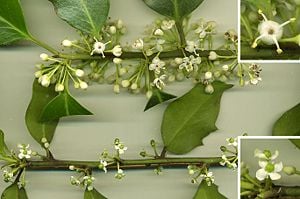
and reduced, sterile stamens with no pollen
See articles on life cycle, gymnosperm, angiosperm, bryophyte, and fern for more complete discussion of plant reproduction.
In flowering plants (angiosperms), flowers are the reproductive structure. A stamen produces gametes called pollen grains, which attach to a pistil, in which the female gametes (ovules) are located. Here, the female gamete is fertilized and develops into a seed. The ovary, which produced the gamete, then grows into a fruit, which surrounds the seed(s). Plants may either self-pollinate or cross-pollinate.
That plants employ many different strategies to engage in sexual reproduction was used, from just a structural perspective, by Carolus Linnaeus (1735 and 1753) to propose a system of classification of flowering plants. Later this subject received attention from Christian Konrad Sprengel (1793) who described plant sexuality as the "revealed secret of nature" and, for the first time, understood the biotic and abiotic interactions of the pollination process. Charles Darwin's theories of natural selection are based on his work.
Flowers, the reproductive structures of angiosperms, are more varied than the equivalent structures of any other group of organisms, and flowering plants also have an unrivaled diversity of sexual systems (Barrett 2002). But sexuality and the significance of sexual reproductive strategies is no less important in all of the other plant groups. The breeding system is the single most important determinant of the mating structure of nonclonal plant populations. The mating structure in turn controls the amount and distribution of genetic variation (Costich, 1995).
Terminology
The complexity of the systems and devices used by plants to achieve sexual reproduction has resulted in botanists and evolutionary biologists proposing numerous terms to describe structures and strategies. Dellaporta and Calderon-Urrea (1993) list and define a variety of terms used to describe the modes of sexuality at different levels in flowering plants. This list is reproduced here (taken from Molner 2004), generalized to fit more than just plants that have flowers, and expanded to include other terms and better definitions.
Individual reproductive unit (a flower in angiosperms)
- Bisexual - Reproductive structure with both male and female equivalent parts (stamens and pistil in angiosperms; also called a perfect or complete flower); other terms widely used are hermaphrodite, monoclinous, and synoecious.
- Unisexual - Reproductive structure that is either functionally male or functionally female. In angiosperms, this condition is also called diclinous, imperfect, or incomplete.
Individual plant
- Hermaphrodite - A plant that has only hermaphrodite reproductive units (flowers, conifer cones, or functionally equivalent structures). In angiosperm terminology, a synonym is monoclinous from the Greek "one bed."
- Monoecious - having unisexual reproductive units (flowers, conifer cones, or functionally equivalent structures) of both sexes appearing on the same plant; from Greek for "one household." Individuals bearing flowers of both sexes at the same time are called simultaneously or synchronously monoecious. Individuals that bear only flowers of a single sex at one time are called consecutively monoecious; "protoandrous" describes individuals that function first as males and then change to females; "protogynous" describes individuals that function first as females and then change to males.
- Dioecious - having unisexual reproductive units (flowers, conifer cones, or functionally equivalent structures) occurring on different individuals; from Greek for "two households." Individual plants are not called dioecious: they are either gynoecious or androecious.
- Because many dioecious conifers show a tendency towards monoecy (that is, a female plant may sometimes produce small numbers of male cones or vice versa), these species are termed subdioecious (McCormick and Andresen, 1963).
- In angiosperm terminology, diclinous ("two beds") includes all species with unisexual flowers, although particularly those with only unisexual flowers (i.e. the monoecious and dioecious species).
- Gynoecious - has only female reproductive structures; the "female" plant.
- Androecious - has only male reproductive structures; the "male" plant.
- Gynomonoecious - has both hermaphrodite and female structures.
- Andromonoecious - has both hermaphrodite and male structures.
- Subandroecious - plant has mostly male flowers, with a few female or hermaphrodite flowers.
- Subgynoecious - plant has mostly female flowers, with a few male or hermaphrodite flowers.
- Trimonoecious (polygamous) - male, female, and hermaphrodite structures all appear on the same plant.
Reproduction in fish
As with the other vertebrates, sexual reproduction is the overwhelming dominant form of reproduction. However, there are several genera of fish that practice true or incomplete parthenogenesis, where the embryo develops without fertilization by a male (Spurway 1953, Williams 1969).
Although vertebrates in general have distinct male and female types, there are fish species that are both males and females (hermaphrodites), either at the same time or sequentially. For example, the amenone fish spend the first part of their lives as males and later become females, and the parrot fish is first female and then male. Some members of the Serranidae (sea basses) are simultaneous hermaphrodites, such as the Serranus and their immediate relatives, Hypoplectrus (the synchronoous hermaphroditic hamlets) (Nelson 1994).
Fertilization may be external or internal. In the yellow perch, eggs are produced by ovaries in the female and sperm is produced by the testes, and they are released through an opening into the environment, and fertilization takes place in the water (Towle 1989). In some live bearers, such as guppies and swordtails, females receive sperm during mating and fertilization is internal (Towle 1989).
Other behaviors related to sexual reproduction include some species, such as the stickleback, built nests from plants, sticks, and shells, and many species that migrate to spawn (Towle 1989).
Reproduction in amphibians
Both external and internal reproduction are known in amphibians. Anurans utilize mostly external fertilization, while salamanders and caecilians largely reproduce internally.
For the purpose of reproduction, most amphibians are bound to fresh water. A few tolerate brackish water, but there are no true sea water amphibians. Several hundred frog species do not need any water whatsoever, but reproduce via direct development, an adaptation that has allowed them to be completely independent from freestanding water. Almost all of these frogs live in wet tropical rainforests and their eggs hatch directly into miniature versions of the adult, bypassing the larval tadpole (or "polliwog") stage entirely. Several species have also adapted to arid and semi-arid environments, but most of them still need water to lay their eggs.
Reproduction in reptiles
Most reptiles reproduce sexually. However, asexual reproduction has been identified in squamates in six families of lizards and one snake. In some species of squamates, a population of females is able to produce a unisexual diploid clone of the mother. This asexual reproduction is called [[parthenogenesis.
Male and female reptiles have cloacae, an opening through which eggs, sperm, and wastes pass. Intercourse is performed by pressing the lips of the cloacae together, during which time the male transfers his sperm to the female. The female lays amniotic eggs in which the young gestate. Nevertheless, a few species, including most waterfowl and ostriches, have a phallus shaped organ analogous to the mammals' penis. Many male snakes rely on scent to find females, with fertilization being internal.
Reproduction in birds
With rare exceptions, birds generally practice sexual reproduction. There are cases of parthenogenesis in birds, whereby an embryo develops without fertilization by a male (Savage 2005).
Although most male birds have no external sex organs, the male does have two testes which become hundreds of times larger during the breeding season to produce sperm. The female's ovaries also become larger, although only the left ovary actually functions.
In the males of species without a phallus, sperm is stored within the proctodeum compartment within the cloaca prior to copulation. During copulation, the female moves her tail to the side and the male either mounts the female from behind or moves very close to her. He moves the opening of his cloaca, or vent, close to hers, so that the sperm can enter the female's cloaca, in what is referred to as a cloacal kiss. This can happen very fast, sometimes in less than one second.
The sperm is stored in the female's cloaca for anywhere from a week to a year, depending on the species of bird. Then, one by one, eggs will descend from the female's ovaries and become fertilized by the male's sperm, before being subsequently laid by the female. The eggs will then continue their development in the nest.
Many waterfowl and some other birds, such as the ostrich and turkey, do possess a phallus. Except during copulation, it is hidden within the proctodeum compartment within the cloaca, just inside the vent. The avian phallus is purely a copulatory organ and is not used for expelling urine.
The three mating systems that predominate among birds are polyandry, polygyny, and monogamy. Monogamy (having one partner for reproduction and raising the young) is seen in approximately 91 percent of all bird species. Polygyny (one male with more than one female) constitutes 2 percent of all birds, and polyandry (one female with more than one male) is seen in less than 1 percent.
Monogamous species of males and females pair for the breeding season. In some cases, the individuals may pair for life. For example, the albatross, bald eagle, and Canadian goose, as well as species of macaws, owls, and crows, mate for life. When the mate dies, there is often a re-mating of the surviving bird. The parental behavior most closely associated with monogamy is male incubation. Monogamy does not necessarily translate to fidelity among the pairs, as examples to the contrary are known.
Reproduction in mammals
Incidents of asexual reproduction are unknown in mammals, although some consider artificial cloning to be an example, as well as the natural production of multiple clones from a single fertilized egg, such as done by some armadillos producing quadruplets by polyembryony.
Mammal mating systems include monogamy, whereby one male and one female have an exclusive mating relationship, polygamy, whereby one or more males have an exclusive relationship with one or more females, and promiscuity, whereby any male and female will mate within the social group. The most common mating system among vertebrates is polygyny, a type of polygamy, whereby one male has an exclusive relationship with one or more females. Whereas most birds engage in monogamous relationships, few mammal species do.
Placentals
In placental mammals, offspring are born as juveniles: complete animals with the sex organs present although non-functional. After several months or years, the sex organs develop further to maturity and the animal becomes sexually mature. Most female mammals are only fertile during certain periods and during those times, they are ready to mate. Individual male and female mammals meet and carry out copulation.
The male reproductive system contains two main divisions: the penis, which carries the sperm inside it, and the testes, which produce the sperm. In humans, both of these organs are outside the abdominal cavity, but they can be primarily housed within the abdomen in other animals. Sperm are the smaller of the two gametes and are generally very short-lived, requiring males to produce them continuously from the time of sexual maturity until death. They are motile and swim by chemotaxis.
The female reproductive system likewise contains two main divisions: the vagina and uterus, which act as the receptacle for the sperm, and the ovaries, which produce the female's ova. All of these parts are always internal. The vagina is attached to the uterus through the cervix, while the uterus is attached to the ovaries via the Fallopian tubes.
The ova are larger than sperm and are generally all created by birth. They are for the most part stationary, aside from their transit to the uterus, and contain nutrients for the later zygote and embryo. At certain intervals, the ovaries release an ovum (the singular of ova), which passes through the fallopian tube into the uterus.
If, in this transit, it meets with sperm, the sperm penetrate and merge with the egg, fertilizing it. The zygote then implants itself in the wall of the uterus, where it begins the processes of embryogenesis and morphogenesis. When developed enough to survive outside the womb, the cervix dilates and contractions of the uterus propel the fetus through the birth canal, which is the vagina.
Over a regular interval, a process of oogenesis matures one ovum to be sent down the Fallopian tube attached to its ovary in anticipation of fertilization. If not fertilized, this egg is flushed out of the system through menstruation in humans and great apes and reabsorbed in all other mammals in the estrus cycle.
Gestation, called pregnancy in humans, is the period of time during which the fetus develops, dividing via mitosis inside the female. During this time, the fetus receives all of its nutrition and oxygenated blood from the female, filtered through the placenta, which is attached to the fetus' abdomen via an umbilical cord. This drain of nutrients can be quite taxing on the female, who is required to ingest significantly higher levels of calories. In addition, certain vitamins and other nutrients are required in greater quantities than normal, often creating abnormal eating habits. The length of gestation, called the gestation period, varies greatly from species to species; it is 38 weeks in humans, 56-60 in giraffes and 16 days in hamsters.
Once the fetus is sufficiently developed, chemical signals start the process of birth, which begins with contractions of the uterus and the dilation of the cervix. The fetus then descends to the cervix, where it is pushed out into the vagina, and eventually out of the female. The newborn, which is called an infant] in humans, should typically begin respiration on its own shortly after birth. Not long after, the placenta is passed as well. Most mammals eat this, as it is a good source of protein and other vital nutrients needed for caring for the young. The end of the umbilical cord attached to the young’s abdomen eventually falls off on its own.
Humans. Externally, humans follow the same basic physical process as other placentals. However, there is also a scientific and popular tendency to extrapolate from the animal world to speculate on the normal state of human behavior, such as regarding issues of monogamy, promiscuity, and so forth. Particularly, there is a tendency to apply social Darwinism to draw conclusions as to the postulated merit of men or women being promiscuous (see the discussion). However, most religions would see such an extrapolation as not being justified because humans are unique, not only in terms of the physical nature of their sexuality, but also in terms of having an inner, or spiritual essence (see discussion). In terms of the physical nature, unlike many animals in which sexual activity is restricted to near the time of ovulation, the human menstrual cycle allows reproduction year round and lacks overt signs of the time of ovulation. Such a system fosters receptivity to sexual intimacy at any time, thus promoting pair bonding and allowing sex, considered by many religious traditions as ideally a holy act, to encourage and cement the bonds of love between husband and wife.
Monotremes
Monotremes, only five species of which exist, all from Australia and New Guinea, lay eggs. They have one opening for excretion and reproduction called the cloaca. They hold the eggs internally for several weeks, providing nutrients, and then lay them and cover them like birds. After less than two weeks, the young hatches and crawls into its mother’s pouch, much like marsupials, where it nurses for several weeks as it grows.
Marsupials
Marsupials reproduce in essentially the same manner as placentals, though their young are born at a far earlier stage of development than other mammals. After birth, marsupial joeys crawl into their mother’s pouch and attach to a teat, where they receive nourishment and finish developing into self-sufficient animals.
ReferencesISBN links support NWE through referral fees
- Barrett, S. C. H. 2002. The evolution of plant sexual diversity. Nature Reviews Genetics 3(4): 274-284.
- Costich, D. E. 1995. Gender specialization across a climatic gradient: experimental comparison of monoecious and dioecious Ecballium. Ecology76 (4): 1036-1050.
- Darwin, C. 1877. The Different Forms of Flowers on Plants of the Same Species. London: John Murray.
- Dellaporta, S.L. and A. Calderon-Urrea. 1993. Sex determination in flowering plants. The Plant Cell 5: 1241-1251.
- Gowaty, P. A. 1983. Male parental care and apparent monogamy among Eastern Bluebirds (Sialia sialis). The American Naturalist 121(2):149-160.
- Heng, H. H. 2007. Elimination of altered karyotypes by sexual reproduction preserves species identity. Genome 50: 517-524.
- Lahr, D. J., L. W. Parfrey, E. A. Mitchell, L. A. Katz, and E. Lara. 2011. The chastity of amoebae: re-evaluating evidence for sex in amoeboid organisms. Proc Biol Sci. 278(1715): 2081-90. Retrieved January 6, 2012.
- Linnaeus, C. 1735. Systema Naturae. Amsterdam.
- Maynard Smith, J. 1978. The Evolution of Sex. Cambridge University Press. ISBN 0-521-29302-2.
- Mayr, E. 2001. What Evolution Is. New York: Basic Books. ISBN 0465044255.
- McGraw-Hill (Publisher). 2004. McGraw-Hill Concise Encyclopedia of Science and Technology, 5th Edition. McGraw Hill Professionals. ISBN 0071429573.
- Molnar, S. (2004). Plant Reproductive Systems. Internet version posted February 17, 2004. Retrieved June 20, 2005.
- Nelson, J. S. 1994. Fishes of the World, 3rd Edtion. New York: John Wiley & Sons. ISBN 0471547131.
- Otto, S. P., D. B. Goldstein. 1992. Recombination and the evolution of diploidy. Genetics 131: 745-751.
- Pang, K. 2004. Certificate Biology: New Mastering Basic Concepts. Hong Kong.
- Rieger, R., A. Michaelis, and M. M. Green. 1991. Glossary of Genetics, Fifth Edition. Springer-Verlag. ISBN 0-387-52054-6
- Tobler, M., and I. Schlupp. 2005. Parasites in sexual and asexual mollies (Poecilia, Poeciliidae, Teleostei): a case for the Red Queen? Biol. Lett. 1(2): 166-168.
- Towle, A. 1989. Modern Biology. Austin, TX: Holt, Rinehart and Winston. ISBN 0030139198.
- Savage, T. F. 2005. A guide to the recognition of parthenogenesis in incubated turkey eggs. Oregon State University. Retrieved October 11, 2006.
- Spurway, H. 1953. Spontaneous parthenogenesis in a fish. Nature 171: 437.
- Williams, W. L. 1969. Review of Fertilization: Comparative Morphology, Biochemistry, and Immunology, Volume 1 by C. B. Metz and A. Monroy. The Quarterly Review of Biology 44(1): 78-80.
Credits
New World Encyclopedia writers and editors rewrote and completed the Wikipedia article in accordance with New World Encyclopedia standards. This article abides by terms of the Creative Commons CC-by-sa 3.0 License (CC-by-sa), which may be used and disseminated with proper attribution. Credit is due under the terms of this license that can reference both the New World Encyclopedia contributors and the selfless volunteer contributors of the Wikimedia Foundation. To cite this article click here for a list of acceptable citing formats.The history of earlier contributions by wikipedians is accessible to researchers here:
The history of this article since it was imported to New World Encyclopedia:
Note: Some restrictions may apply to use of individual images which are separately licensed.
